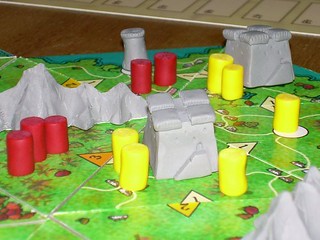It's alright, I'm not talking about prototypes made from raw meat, disappearing ink or short-lived radioisotopes*, but the life-span of components as the prototypes of a game march on.
I recently read a New Scientist story about how truth decays over time (reg. required).
Before Copernicus, everyone knew that the Earth was the centre of the universe. It was a fact. Then, the sun was the centre of the universe. Now we know that we live on an uncharted backwater at the unfashionable end of the Western Spiral Arm of the Milky Way, one of billions of galaxies in the observable universe.
Similarly, there used to be four elements: earth, air, fire and water. Everything was made of those in different quantities. Then there were modern elements, made of indivisible atoms. Then it turned out that you could divide atoms: into protons, neutrons and electrons. But they were indivisible. Now it turns out that protons and neutrons can be divided into quarks. But they are indivisible, honest.
This got me thinking about how the components of a game have a half-life during the prototyping process.
During the prototyping phase components come and go. You try something, sometimes it works, sometimes it doesn't, even the things that work will likely evolve over time. The half-life of a prototype component is related to how many versions of the game you expect it to remain unchanged through. Obviously, this can relate to physical components, rules, designs, keywords, in-game text, even rules.
Through the development of Codename: Vacuum, there have already been lots of changes and it's probably only on it's third or fourth version (I really should keep better track of these things!). Some cards have had superficial changes (the name has changed, for example), others have been completely re-designed. Sometimes I add a keyword to a whole class of cards, that in no way changes what they do, but makes the explanation easier in the rules. But it affects each of those cards, requiring reprinting and cutting out.
The half-life of a component can vary from under one (not likely to survive to the next version), through one (50% chance of making it to the next version) up to a very large number (will remain unchanged through many versions).
Recognising that components have a half-life, and trying to make an educated guess as to what it might be enables you to invest a reasonable amount of time in a component. It doesn't make sense to pay an artist hundreds of pounds to create some art for a card entitled 'Boffin' if the next version of the game has replaced that card with a card entitled 'Calculation Engine' that does exactly the same thing.
As time goes on, the average half-life of your components should increase as the game begins to settle down and the changes between versions become less sweeping. That's why my early prototypes are scribbled on paper, but later ones can include art and hand-made FIMO pieces:

At some point in a game's life cycle you've got to get it in front of other gamers, probably by sending it out to volunteers. I've already got people volunteering to try out Codename: Vacuum for me. Using the estimated half-life of prototype components could help you make the decision of when to start that process: if you're going to have to send them new components after every play - it's probably not ready for remote playtesting yet!
* actually, that's given me an idea for a game!



3 comments:
Have you got yourself a 3D printer yet?
Hiya Dave,
No :(
I've a Canon PIXMA ix6500 A3 colour printer and a box of spare wooden bits from making Border Reivers, It's Alive!, Carpe Astra and Sumeria (along with bits from various prototypes I received). Anything more complicated than that gets the FIMO treatment :)
Cheers,
Jack
3D printing is pretty exciting. I'd love to get my hands on one.
Post a Comment